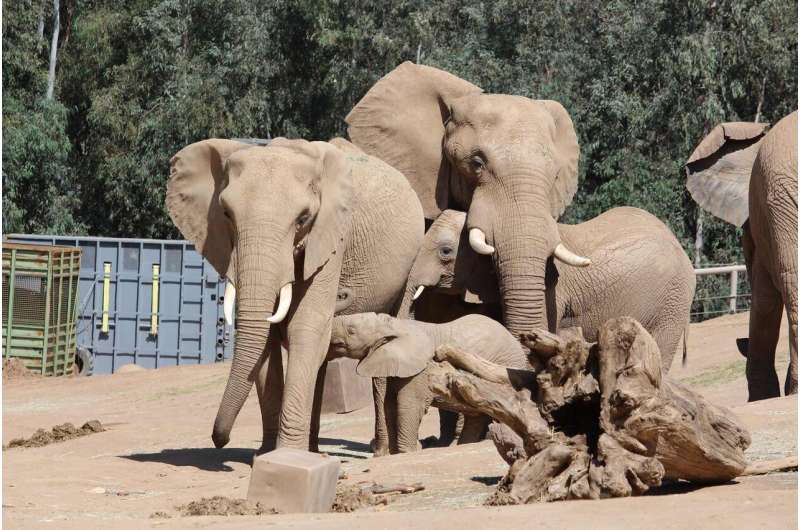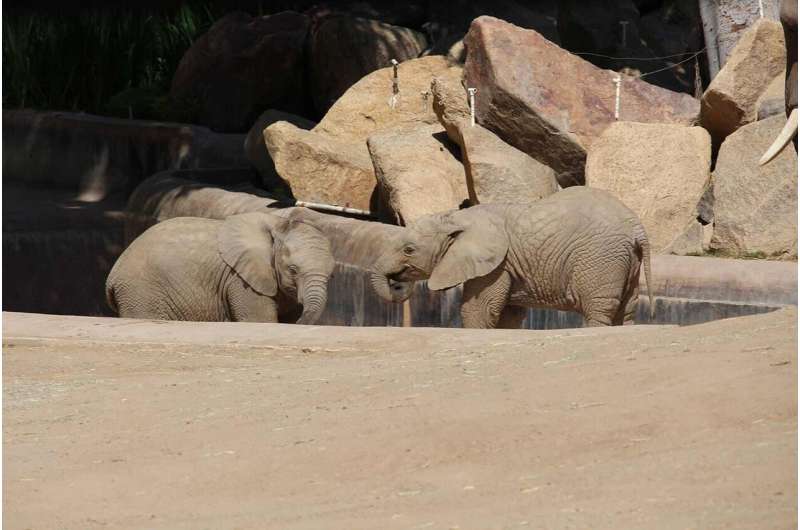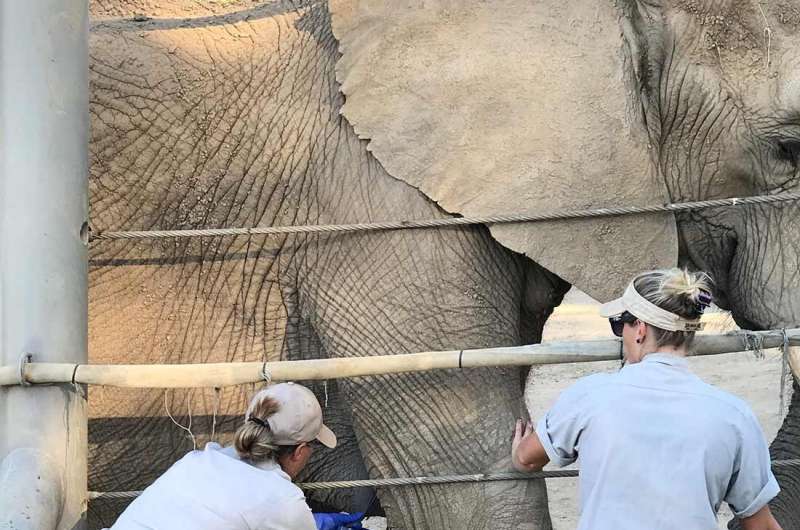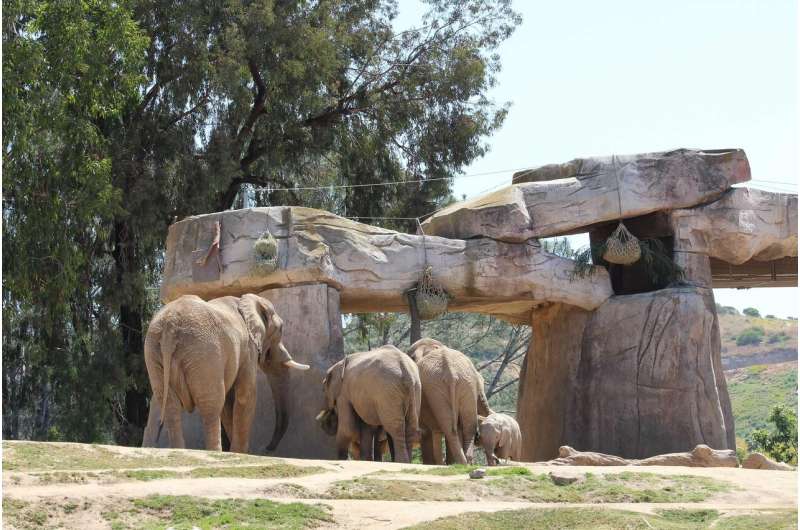Jumbo undertaking: Elephant milk under the microscope

On a recent sunny day at the San Diego Zoo Safari Park, a team of specialized zookeepers collected breast milk samples from two female elephants nursing their 1-year-old calves. Unlike the mechanical breast pumps used by human mothers, or the machines employed by dairy cow farmers, the process requires hands-on expertise. It's something of a mammoth effort: Success depends a lot upon how the elephant mothers, called dams, are feeling that day.
"This process is completely voluntary for the elephants," said Katie Kerr, nutritionist at San Diego Zoo Global. "Umngani (dam of Mkhaya) is more willing and comfortable with the process; Ndulamitsi (dam of Umzula) is more reserved."
To date, 66 samples have been collected from Umngani since she gave birth and 19 from Ndulamitsi. Zookeepers extract only a few milliliters per sample, a metaphorical drop compared to young elephants. At birth, a calf consumes approximately 2.5 gallons per day, increasing to more than 5 gallons by the time it reaches its first birthday. To compare, a human mom usually produces about 30 ounces a day to feed her baby.
Approximately 15 miles away, a team of researchers at University of California San Diego School of Medicine anxiously awaits the arrival of the elephant breast milk samples. "The San Diego Zoo Safari Park does an amazing job collecting samples for us to analyze," said Lars Bode, professor of pediatrics at UC San Diego School of Medicine and director of Larsson-Rosenquist Foundation Mother-Milk-Infant Center of Research Excellence (MOMI CORE).
Elephant and human breast milk, it turns out, are remarkably similar in chemistry and constitution.
"We want to connect the dots of milk compositions to improve overall health in several species, and elephants are a great foot in the door," said Bode. A very big door, indeed.

Formula for Success
The collaboration between Safari Park and UC San Diego began with a visit in 2017, said Bode. "It was an annual work outing, an event that's both social and educational and allows my team to get out of the lab and bond." During the visit, Bode struck up a conversation with Andrea Fidgett, director of nutritional services at San Diego Zoo Global, the parent organization which operates both Safari Park and the San Diego Zoo.
"We started talking about our mutual interest in milk composition and infant health," said Fidgett.
In early 2018, nutritionist Kerr and the elephant care team began reviewing feeding plans for two soon-to-be born calves. "We found we don't have a lot of data on the compounds of elephant breast milk to guide our decisions for this species, but with two calves imminent we would have an opportunity to produce more data."
Kerr and Fidgett reconnected with Bode. "Teaming up with Lars' team has given us access to advanced technology that will give us insight on how the milk components change over time in different elephant moms and how we can use that knowledge to improve overall health and survival of elephant calves that are assist-reared due to dam illness or other unforeseen problems," said Kerr.
Bode describes the research in terms of a triad—mother, milk, infant. "Milk connects maternal-infant health, benefits both mom and baby and holds the promise to treat or even prevent some of today's most devastating diseases," he said. "Our work with San Diego Zoo Safari Park and data from samples will help us understand how different milk components evolve over time and between different mammals and why these compounds are in milk in the first place."
In 2016, Safari Park started work in Kenya with Reteti Elephant Sanctuary to share animal care experience and build capacity for the care of orphaned elephants. As the partnership grew, Fidgett began working with local Kenyan companies to develop and manufacture elephant formula. "We want to look at elephant milk at the macro level to better understand the health benefits and nutritional value. The discoveries we learn from UC San Diego can potentially lead to refining formula for elephants that are orphaned in Northern Kenya and beyond," she said.
Bode said the work may improve human formula too. "While we increase our understanding of just how powerful breastfeeding and breast milk are, we also have an obligation to help improve the composition and health benefits of infant formula for when moms cannot or decide not to breastfeed their babies. "

The Milk Man
Human breast milk is a complex blend of proteins, fats, minerals, vitamins and sugar molecules called human milk oligosaccharides, or HMOs. There are about 150 types of HMOs. Like thumbprints, breast milk components and concentrations are unique to each nursing mother, in humans and perhaps in elephants too.
HMOs are natural prebiotics that contribute to the shaping of the infant gut microbiome, which may affect disease risk, such as infectious diarrhea or necrotizing enterocolitis, a serious condition that impacts the intestine of premature infants. HMOs potentially also reduce the risk for non-communicable diseases, such as asthma, allergies and obesity later in life.
"The components of breast milk are remarkable in what they can do and the health benefits to the infant and mother," said Bode. "There are bacteria and even stem cells in breast milk. There are also several different immune cells that provide protection. A mother's body can sense what is in the environment and what immune cells and antibodies need to be delivered to an infant at a given time." Breastfeeding has been shown to not only lower the risk of health issues in children, but also reduce the risk of breast and ovarian cancer in mothers.
Bode has dedicated his career to studying human milk. Once an athlete who used specialized diets for optimal performance, he changed career paths after an internship at a baby formula company in college, where he learned about the "magical" ingredients of human milk. "It was a defining moment for me," he said.
As director of MOMI CORE at UC San Diego, which focuses on fostering collaborative research, education and clinical practice to improve the health and development of infants, mothers and society as a whole, Bode and a diverse team of collaborators are examining how compounds in human milk might be used to treat chronic illnesses in adults, such as arthritis or inflammatory bowel disease.
"We want to understand from Mother Nature what works and how we can use that information to develop new therapeutics for diseases, from cancer to diabetes to cardiovascular disease," said Bode. "The treatment for some illnesses may have been right in front of us this entire time."

Wild Path Forward
The researchers and zookeepers hope to expand their partnership to other species, such as the white rhino. "The process that will be used to examine elephant milk could be applied to species on the brink of extinction," said Kerr. "We have started collecting milk from our southern white rhino dams, and one day these animals may serve as surrogates for northern white rhino calves."
The latter species is particularly imperiled: There are only two northern white rhinos remaining in the world, both living in a Kenyan wildlife reserve under 24-hour guard. Their close relative, the southern white rhino, is more numerous, with an estimated 11,670 living in the wild in southern Africa and 777 animals in captivity. San Diego Zoo Global is committed to developing reproductive technologies (in vitro fertilization, artificial insemination and embryo transfer) to save this species.
"This is the start of a much bigger picture," said Bode. "Multiple other labs at UC San Diego are now involved in the emerging partnership, looking at milk fat composition, the metabolome, as well as the microbiome, not only in milk, but in all parts of the mother-milk-infant triad. This is a great example of how we break down the silos within and between institutions like UC San Diego and the San Diego Zoo Safari Park. It's these non-traditional intersections where innovation and discoveries are made."
Bode and his team continue to have meetings and conversations with Kerr and Fidgett to establish workflows and strategies that will make the collaboration successful. Milk samples from the first year of lactation will arrive at Bode's lab in early 2020. Researchers will first have to determine how the processes for analyzing human milk need to be adapted to assessing elephant milk. Once that has happened, the group will develop a budget and identify funding for the project.
On a recent field trip to the Safari Park, Bode's team had the opportunity to observe the elephants and watch the calves nursing and at play. "As I watch these fascinating mammals close up, I am incredibly excited that our research findings from human milk could help these beautiful elephants for generations to come."
Provided by University of California - San Diego


















